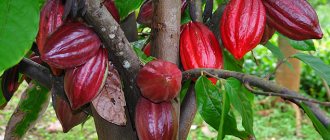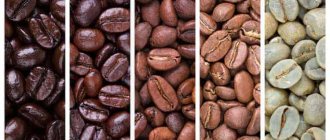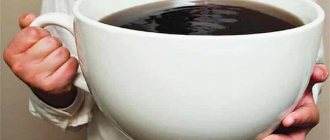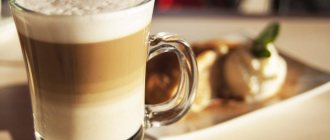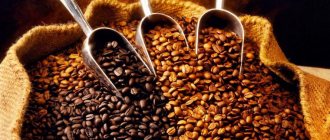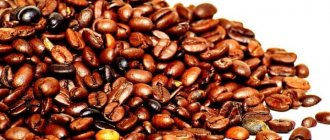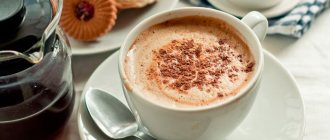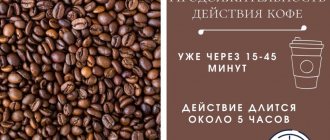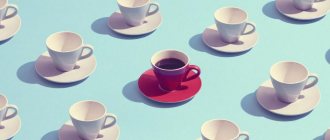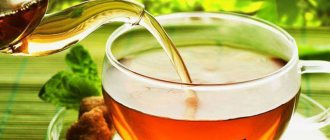Health and coffee
comments 2
Good day, friends. Perhaps everyone knows that daily drinks such as tea and coffee contain a certain amount of a substance called caffeine. It causes a lot of controversy. Some experts talk about its harmful properties, others, on the contrary, about beneficial ones. And since “impact” drinking is invariably popular among the population, the topic raised is very relevant. So, let's figure it out: where has more caffeine - tea or coffee?
We recommend drinking this drink from the Czech Leander porcelain set
General information about caffeine
It is a purine alkaloid and a psychostimulant. In small doses it has a therapeutic effect, and in large doses it is poisonous.
Caffeine was discovered at the beginning of the 19th century. German chemist Ferdinand Runge. In 1832, its relationship with theine was proven, and its structure was elucidated at the end of the 19th century. This was done using artificial synthesis by the German chemist and Nobel Prize winner Emil Hermann Fischer.
Theine is extracted from waste tea and coffee beans. Industrially, it is synthesized from uric acid and xanthine.
Properties of theine
The molecules of theine and caffeine are identical, but... they can be associated with other elements, the result of their impact on the body is different. An important factor is the breakdown of substances in the human body, which occurs at different rates.
Adenosine regulates various physiological processes in the body. It plays a role in promoting sleep and suppressing alertness. It is also called the "fatigue molecule."
Theine, in turn, interferes with the functioning of the receptors that produce adenosine. Therefore, consuming drinks that contain theine prolongs the period of wakefulness and makes a person feel less tired and drowsy.
Effect on the human body
The effects of theine on people vary depending on their sensitivity to this component. It improves digestion, has a positive effect on the central nervous system and promotes a better supply of oxygen to cells.
Caffeine is contraindicated in case of organic diseases of the cardiovascular system, increased excitability, insomnia, severe hypertension and atherosclerosis.
A healthy effect on the body is maintained only with moderate consumption: in high doses, caffeine can lead to exhaustion of the nervous system, and in more severe cases, to psychosis.
Only moderate consumption of drinks can benefit the body.
Effect of caffeine on the human body
Probably everyone knows that caffeine speeds up the heartbeat and dilates blood vessels. But not many people know that there is a complex effect on metabolism. When you drink a drink that contains caffeine, the amount of adrenaline in your body increases, and this directly affects your mental state and metabolism.
Scientists say that fifty milligrams of caffeine will improve mood and increase productivity, but two hundred or three hundred milligrams will lead to heartbeat disturbances and mild tachycardia.
Consuming four hundred to five hundred milligrams can provoke depression. If you decide to drink a liter of caffeine, death will occur.
But how do you know how much caffeine is in your cup?
Content in different drinks
Caffeine is one of the most commonly used natural stimulants in the world. The proportion of theine depends on the ingredients and method of preparation. The largest amount of alkaloid is found in espresso.
Coffee
The proportion of caffeine in coffee can reach up to 2.7%.
There are several variables to consider here:
- The climatic conditions in which the trees grow and their type: Arabica, Robusta, etc.
- Roasting intensity. It also affects its concentration, but to a lesser extent, shaping the taste and aroma more.
The presence of caffeine in the drink depends on the type and roasting of the beans.
Tea
Tea leaves have twice the caffeine content of coffee beans, but the amount of leaves used to make a cup of tea is minimal.
In addition, its effect is weakened by the presence of other nutrients such as essential oils, enzymes and phenolic compounds. As a result, a mug of tea contains less caffeine than the same serving of coffee.
Tea also contains caffeine, but in smaller amounts.
comparison table
Average caffeine content in different types of drinks and coffees:
| Drink | Caffeine mg/100g |
| Espresso | 200 |
| Coffee made using a coffee maker | 115 |
| Americano | 120 |
| Instant coffee | 65 |
| Decaffeinated coffee | 3 |
| Carbonated drinks (in Coca-Cola, Fante, etc.) | 20-40 |
| Tea | 10-60 |
| Hot chocolate | 10 |
How is caffeine extracted from coffee beans?
People started thinking about creating a harmless drink at the beginning of the 20th century. The first to cope with this task were the German inventors Roselius and Wimmer. First, the grains were treated with a strong saline solution, and then with benzene. Later, the latter began to be replaced with chloroform or trichlorethylene.
Attention!
This method was abandoned because carcinogenic compounds remained in the drink. But it is still used for extraction.
The following methods are now used to extract the alkaloid:
- Straight. The unroasted beans are steamed and then placed in a solution that extracts the caffeine. The process is repeated up to 8-12 times until up to 97.9% of the exciting substance is removed. The mixture is then infused in cold water to remove carcinogens from the solution. Only then are the grains roasted.
- Indirect, the second name is Swiss, or Swiss Water. For extraction, water heated to 93°C is used. Then it is passed through carbon filters and extraction is carried out. The coffee beans are soaked again, and the caffeine is again separated from the liquid by evaporation. The advantages of the method are that there is no direct contact with the solvent.
- Carbon monoxide is used as a solvent. The feedstock is treated with steam under high pressure at a temperature of 31.1°C for 10 hours. The alkaloid is squeezed out of the grains, and the remaining substances are preserved. The disadvantage of this option is that it is expensive and requires special equipment; plus - carcinogens do not get into the drink.
The most popular of them is the Swiss method. Caffeine evaporated from water can later be used in the pharmaceutical or food industries.
What determines the amount of caffeine in tea?
The percentage of theine released in a cup of tea depends on the type of leaves used and the steeping time. Therefore, it is recommended to increase the quantity, rather than the brewing time, if you want a stronger tea.
Cooking method
It greatly affects the amount of theine in tea. The longer the infusion in hot water, the higher the caffeine intake. Excessively long infusion concentrates the presence of tannins, which give the tea a bitter taste and reduce the absorption capacity of iron obtained from other products. Milk neutralizes tannins.
Average caffeine content in tea depending on the type and method of preparation:
| View | Caffeine mg/100g |
| Brewed black | 20 |
| Brewed black decaf | 1 |
| Brewed green | 12 |
| Ready to drink (bottled) | 8 |
| Oolong | 25 |
| Pu'er | 10 |
Turmeric latte
Another name for this incredibly healthy drink is golden milk. There is no caffeine in its composition, but it is invigorating, as it is made from several spices. In addition to turmeric itself, it contains ginger, cinnamon and black pepper.
pixabay.com/
Cardamom, vanilla and honey are also sometimes added to the mixture. All of these ingredients have strong anti-inflammatory properties. The chemical element curcumin has proven itself to be a wonderful, soothing, but at the same time invigorating product.
This mixture will provide you with energy and good health for the whole day.
In addition to being cheerful and healthy, this drink also helps to cope with uncontrollable cravings for sweets.
Drinks that can be replaced
To limit your theine intake and at the same time get an energy boost, you need to consume alternative drinks that have beneficial properties, containing antioxidants and valuable substances:
- Barley coffee. It has digestive, anti-inflammatory and antiseptic properties. It maintains stable blood sugar levels, so it can be taken by diabetics, people suffering from anxiety disorders, and pregnant or breastfeeding women. Contains, although in small quantities, vitamins A, B, E, PP and mineral salts, especially phosphorus and potassium.
- Ginseng. This is the root of a perennial herbaceous plant. It produces a medicine that has been used in traditional medicine for thousands of years. The root counteracts stress and fatigue, improves the response of the central nervous system.
- Chicory. It is one of the most popular natural caffeine-free alternatives. This drink with a characteristic slightly bitter taste is obtained from chicory root. It is rich in polyphenols, inulin (soluble fiber), vitamins and mineral salts, and has digestive properties. In addition, it helps balance intestinal flora and control blood sugar levels.
- Matcha tea. It is a highly prized variety grown in Japan. It is rich in vitamins (B1, B2 and C), mineral salts, polyphenols, chlorophyll and carotene. Helps maintain alertness and is a powerful natural antioxidant.
- Raw cocoa. It is obtained from unroasted cocoa beans. Unlike roasted ones, they are processed at low temperatures and for this reason cocoa keeps all their nutritional properties intact. The powder is lighter than traditional cocoa and is an excellent source of antioxidants. It is rich in magnesium, useful for those who suffer from cardiovascular diseases, as well as athletes, as it prevents cramps and relaxes muscles.
- Golden milk. Used in Ayurvedic medicine. Curcumin, its active and main ingredient, is a powerful antioxidant and natural anti-inflammatory agent.
You can quit caffeine without losing strength and energy. You can add other drinks to this list depending on your preferences.
Products with the highest caffeine content
Certain caffeine-containing products have been identified. The list of those that contain the most of this alkaloid is relatively small:
- Chocolate. After consuming this product, a person feels a surge of strength. This is due to the presence of an invigorating component in chocolate. One hundred grams of sweet delicacy (black or milk) contains about 30 mg. There is no alkaloid in white chocolate.
- Chocolate ice-cream. 200 g of this product contains about 80 mg of natural stimulant.
- Cocoa. This product has been known to everyone since childhood. It is noted that 200 ml of prepared hot cocoa contains about 30 mg of the invigorating alkaloid. In 100 g of dry powder the concentration reaches 230 mg.
- Energy bars. They contain up to 75 mg of an invigorating substance.
Chemistry
Both drinks are a complex of active substances that can have a tonic effect. First of all, it is worth highlighting the alkaloids around which there is so much controversy: caffeine and its tea analogue, theine. There is indeed more theine in brewed leaves, but the amount of brew itself is smaller, which reduces the concentration in the finished drink.
In addition to the alkaloid, tea leaves include:
- Tannins (tannins) – up to 20%. Due to them, the drink acquires an astringent taste and astringency;
- More than 20 essential oils , most of which evaporate when heated;
- Guanine;
- Theophylline;
- Theobromine;
- Adenine.
In addition to these substances, the brew contains a whole vitamin complex, including C, B, PP, amino acids, carbohydrates
The composition of coffee, not counting alkaloids, is no less rich:
- More than 70 aromatic compounds that are quickly destroyed by oxidation, that is, contact with oxygen. That is why it is recommended to store grains in airtight packaging and in conditions close to ideal;
- Chlorogenic acid;
- Mineral salts;
- Methyl betaine nicotinic acid;
- Oils;
- Cellulose.
Smoothie
Another substitute for coffee, which is firmly entrenched in the diet of modern people. Smoothies, along with cocoa, are also both a drink and a dessert.
pexels.com/Mikhail Nilov
A nourishing, energy-boosting smoothie that is ideal for consumption in the morning or around noon.
Feel free to add not only fruits, but also healthy vegetables or herbs. Plant-based milk or yogurt can be a great base for it. Registered dietitian and professor of biomedical sciences at the University of Missouri, Natalie Allen, recommends adding protein to your smoothie to help fill you up.
“Smoothies are a great way to start the day with carbohydrates, fiber, antioxidants and protein,” she said.
Harmful properties of caffeine
Excessive consumption of an alkaloid can negatively affect the health of the body, namely:
- helps increase blood pressure and pulse;
- increases the risk of heart attack, stroke, stomach diseases and gout (when drinking more than 4 cups of coffee per day);
- provokes diseases of the urinary system (cystitis) and problems with the mammary gland;
- causes insomnia;
- reduces the chances of getting pregnant in young women;
- reduces collagen production and promotes premature aging;
- causes allergies and reduces the strength of bone tissue.
Read the blog: Bacopa Monnieri is the best nootropic for improving memory
Why does caffeine cause anxiety?
It is estimated that 80% of the world's population consumes a caffeinated product daily.
The United States Department of Agriculture (USDA) and the European Food Safety Authority (EFSA) define a safe level of caffeine intake at 400 mg per day, 200 mg as a single dose, or 3 mg per kg of body weight (, ,).
Due to its stimulant effects, caffeine has been linked to benefits such as improved concentration, athletic performance, mood, and increased metabolism (, , , ).
However, consuming large amounts—such as single doses over 500 mg—may raise some concerns (,).
In high doses, caffeine has been linked to anxiety, restlessness and sleep problems. In addition, some studies show that its regular consumption, even in moderate quantities, can cause chronic headaches and migraines (, ,).
Additionally, caffeine is considered mildly addictive and some people may be more susceptible to developing dependence ().
Summary:
Caffeine is a popular stimulant compound found in many foods and drinks, including coffee and tea. It has many beneficial properties, but excessive consumption may cause some side effects.
Nitro brew coffee
It is unlikely that you drink this drink every morning, but it is worth mentioning - this is an unusual coffee that is not prepared everywhere.
Nitro brew is a bubblier version of the previously described cold brew. It is cooked in a barrel, which is then infused with nitrogen to produce a sweeter, creamier flavor without the added sugar or cream.
Nitro coffee is one of the most powerful sources of caffeine. One serving contains 215 mg of caffeine.
The main difference from cold brew is its texture - nitro brew boasts a rich body and foam that can be compared in texture to beer.
Cocoa
Cocoa is rich in theobromine, a mild stimulant of the central nervous system. According to licensed nutritionist Monica Reinagel , it's best to stick to sugar-free formulas.
In an article for Food & Nutrition magazine, she said that those who praise the taste of dark chocolate without sugar, fat and virtually no calories will definitely like this drink.
The nutritionist is sure that cocoa is much better than coffee, which so often lacks something.
“A cup of brewed cocoa with or without milk brings complete satisfaction, because cocoa is a drink and a dessert in one,” Monica is sure.
At the same time, according to Monica, there is actually nothing new in cocoa. Its taste was enjoyed by the indigenous people of Central America 1500 BC.
A few words about tannin
This is the correct name for the caffeine contained in tea. Even at the dawn of research, a substance was discovered in tea that was classified as a separate group of alkaloids. But later it was proven that its effect is similar to caffeine. This is where the confusion began.
More recent data has brought some clarity. The tannin contained in tea inhibits the effect of caffeine. Therefore, we experience different effects from a cup of espresso or strong tea. In the first case there is a sharp jump in energy, in the second there is a smoother and longer, invigorating effect.
Where do you think there is more caffeine? Let's discuss in the comments!
Summarize
- The method of preparing tea and coffee affects caffeine levels.
- While black tea, espresso and coffee contain more caffeine per serving, green tea also contains small amounts. The levels in white teas vary greatly, while herbal teas contain virtually no caffeine.
- If you want to reduce your caffeine intake, try steeping your tea for shorter amounts of time and opting for decaffeinated varieties of your favorite drinks.
- However, if you enjoy the effects of caffeine, try not to consume more than 400 mg per day.
The article was prepared by experts for informational purposes only. It should not be used as a guide for treating medical conditions and is not a substitute for professional medical advice, diagnosis, or treatment. In case of illness or any symptoms, you should always consult a doctor and not self-medicate.
Tags: Coffee, caffeine, Tea
About the author: Alexander Fedorov
Candidate of Biological Sciences, biologist, nutrition expert. Graduated from Stavropol State University with a degree in Biology at the Faculty of Biology and Chemistry.
- Related Posts
- Is it good to drink warm milk with honey at night?
- Orange juice: benefits and harm to the body
- Almond milk vs soy milk: which is better?
« Previous entry
Summer coffee drinks
The list of such drinks includes summer lattes, cold frappe, various coffee smoothies, and other experiments with espresso and milk, cream and ice cream. These drinks are popular during hot weather. They usually include one shot of espresso, ice or ice cream and some additives to taste (candy or chocolate, for example). When you're craving a midday treat, creamy, icy drinks like these are just the thing.
Although it is worth noting right away that this is not the healthiest choice, you can treat yourself to them from time to time. The classic summer latte or Frappuccino served in coffee shops contains about 65 milligrams of caffeine.

